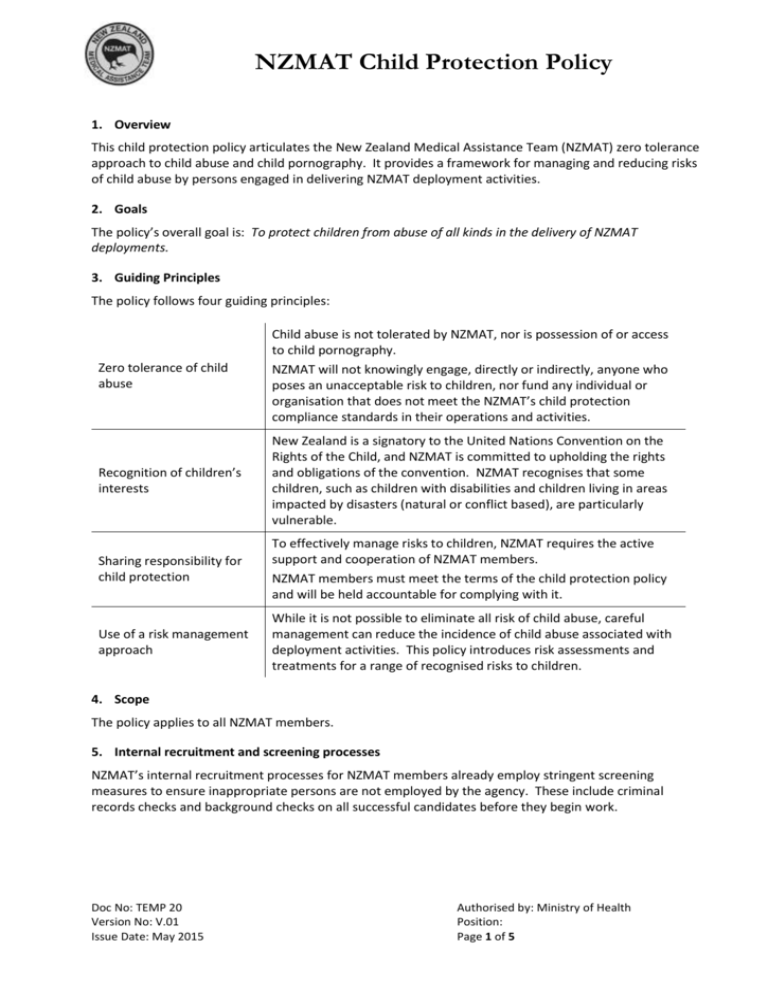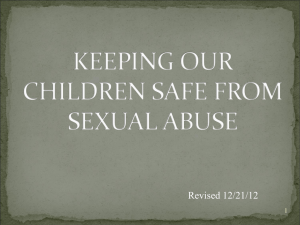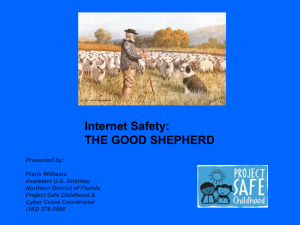
NZMAT Child Protection Policy
1. Overview
This child protection policy articulates the New Zealand Medical Assistance Team (NZMAT) zero tolerance
approach to child abuse and child pornography. It provides a framework for managing and reducing risks
of child abuse by persons engaged in delivering NZMAT deployment activities.
2. Goals
The policy’s overall goal is: To protect children from abuse of all kinds in the delivery of NZMAT
deployments.
3. Guiding Principles
The policy follows four guiding principles:
Zero tolerance of child
abuse
Child abuse is not tolerated by NZMAT, nor is possession of or access
to child pornography.
NZMAT will not knowingly engage, directly or indirectly, anyone who
poses an unacceptable risk to children, nor fund any individual or
organisation that does not meet the NZMAT’s child protection
compliance standards in their operations and activities.
Recognition of children’s
interests
New Zealand is a signatory to the United Nations Convention on the
Rights of the Child, and NZMAT is committed to upholding the rights
and obligations of the convention. NZMAT recognises that some
children, such as children with disabilities and children living in areas
impacted by disasters (natural or conflict based), are particularly
vulnerable.
Sharing responsibility for
child protection
To effectively manage risks to children, NZMAT requires the active
support and cooperation of NZMAT members.
NZMAT members must meet the terms of the child protection policy
and will be held accountable for complying with it.
Use of a risk management
approach
While it is not possible to eliminate all risk of child abuse, careful
management can reduce the incidence of child abuse associated with
deployment activities. This policy introduces risk assessments and
treatments for a range of recognised risks to children.
4. Scope
The policy applies to all NZMAT members.
5. Internal recruitment and screening processes
NZMAT’s internal recruitment processes for NZMAT members already employ stringent screening
measures to ensure inappropriate persons are not employed by the agency. These include criminal
records checks and background checks on all successful candidates before they begin work.
Doc No: TEMP 20
Version No: V.01
Issue Date: May 2015
Authorised by: Ministry of Health
Position:
Page 1 of 5
NZMAT Child Protection Policy
6. Ensure risks to children managed in disaster situations
NZMAT recognises that children living in areas impacted by disasters (natural or conflict based) are
particularly vulnerable. All NZMAT members must comply with this policy. Risks to children must always
be considered when developing disaster response activities.
7. Child protection code of conduct sample
I, <insert name>, engaged by the Ministry of Health, agree that while on a NZMAT deployment, I
will:
treat children with respect regardless of race, colour, sex, language, religion, political or
other opinion, national, ethnic or social origin, property, disability, birth or other status.
not use language or behaviour towards children that is inappropriate, harassing, abusive,
sexually provocative, demeaning or culturally inappropriate.
not engage children in any form of sexual activity or acts, including paying for sexual
services or acts, where under the law(s) applicable to the child, the child is below the age of
consent or the act(s) are an offence under relevant laws.
wherever possible, ensure that another adult is present when working in the proximity of
children.
not invite unaccompanied children into my home, unless they are at immediate risk of
injury or in physical danger.
not sleep close to unsupervised children unless absolutely necessary, in which case I must
obtain my supervisor’s permission, and ensure that another adult is present if possible.
use any computers, mobile phones, or video and digital cameras appropriately, and never
to exploit or harass children or to access child pornography through any medium (see also
‘Use of children’s images for work related purposes’).
refrain from physical punishment or discipline of children (excluding my own children).
refrain from hiring children for domestic or other labour which is inappropriate given their
age or developmental stage, which interferes with their time available for education and
recreational activities, or which places them at significant risk of injury.
comply with all relevant New Zealand and local legislation, including labour laws in relation
to child labour.
immediately report concerns or allegations of child abuse in accordance with appropriate
procedures.
Doc No: TEMP 20
Version No: V.01
Issue Date: May 2015
Authorised by: Ministry of Health
Position:
Page 2 of 5
NZMAT Child Protection Policy
8. Use of children’s images for work-related purposes
When photographing or filming a child for work related purposes, I must:
before photographing or filming a child, assess and endeavour to comply with local
traditions or restrictions for reproducing personal images.
before photographing or filming a child, obtain consent from the child or a parent or
guardian of the child. As part of this I must explain how the photograph or film will be
used.
ensure photographs, films, videos and DVDs present children in a dignified and respectful
manner and not in a vulnerable or submissive manner. Children should be adequately
clothed and not in poses that could be seen as sexually suggestive.
ensure images are honest representations of the context and the facts.
ensure file labels do not reveal identifying information about a child when sending images
electronically.
I understand that the onus is on me, as a person engaged by the Ministry of Health, to use
common sense and avoid actions or behaviours that could be construed as child abuse when
taking part in a NZMAT deployment.
Signed:_____________________________________
Date:_______________________________________
9. International child protection instruments
Instrument
Source
The United Nations Convention on the Rights
of the Child
www.unicef.org/crc
Optional Protocol to the United Nations
Convention on the Rights of the Child on the
sale of children, child prostitution and child
pornography
www.unhchr.ch/html/menu2/dopchild.htm
Optional Protocol to the United Nations
Convention on the Rights of the Child on the
involvement of children in armed conflict
www.unhchr.ch/html/menu2/6/protocolchild.htm
Geneva Declaration of the Rights of the Child
www.unhchr.ch/html/menu3/b/25.htm
ILO Convention 182 Concerning the
Prohibition and Immediate Action for the
Elimination of the Worst Forms of Child
Labour
www.ilo.org/ilolex
Doc No: TEMP 20
Version No: V.01
Issue Date: May 2015
Authorised by: Ministry of Health
Position:
Page 3 of 5
NZMAT Child Protection Policy
10. Glossary
child (plural ‘children’)
In accordance with the United Nations Convention on the Rights
of the Child, ‘child’ means every human being below the age of 18
years unless under the law applicable to the child, majority is
attained earlier.
child abuse
All forms of physical or mental violence, injury or abuse,
maltreatment or exploitation, including sexual abuse.
child protection
An activity or initiative designed to protect children from any form
of harm, particularly arising from child abuse or neglect.
child pornography
In accordance with the Optional Protocol to the Convention on
the Rights of the Child, ‘child pornography’ means ‘any
representation, by whatever means, of a child engaged in real or
simulated explicit sexual activities or any representation of the
sexual parts of a child for primarily sexual purposes.’
child-sex tourism
The sexual exploitation of children by men or women who travel
from one place to another, usually from a richer country to one
that is less developed, and there engage in sexual acts with
children.
criminal record check
A check of an individual’s criminal history record. In New Zealand,
national criminal record checks are available through the New
Zealand Police Department.
Individuals need to give their consent to a criminal record check
and should be informed of the purpose for which the resulting
police clearance certificate will be used, including sighting by
NZMAT.
online grooming
The act of sending an electronic message with indecent content to
a recipient whom the sender believes to be under 16 years of age,
with the intention of procuring the recipient to engage in or
submit to sexual activity with another person, including but not
necessarily the sender.
particularly vulnerable
children
Children who are particularly vulnerable to abuse, such as
children with physical and mental disabilities, homeless children,
child sex workers and children impacted by disasters.
police clearance certificate
The certificate showing the results of a criminal record check,
issued by the police or other authority responsible for conducting
such checks.
working with children
Working in a position that involves regular contact with children,
either under the position description or due to the nature of the
work environment.
Doc No: TEMP 20
Version No: V.01
Issue Date: May 2015
Authorised by: Ministry of Health
Position:
Page 4 of 5
NZMAT Child Protection Policy
11. Acknowledgement
NZMAT would like to acknowledge the Australian Government, AusAID Child Protection Policy (January
2009) upon which this document is based.
Doc No: TEMP 20
Version No: V.01
Issue Date: May 2015
Authorised by: Ministry of Health
Position:
Page 5 of 5









